LInk tar x
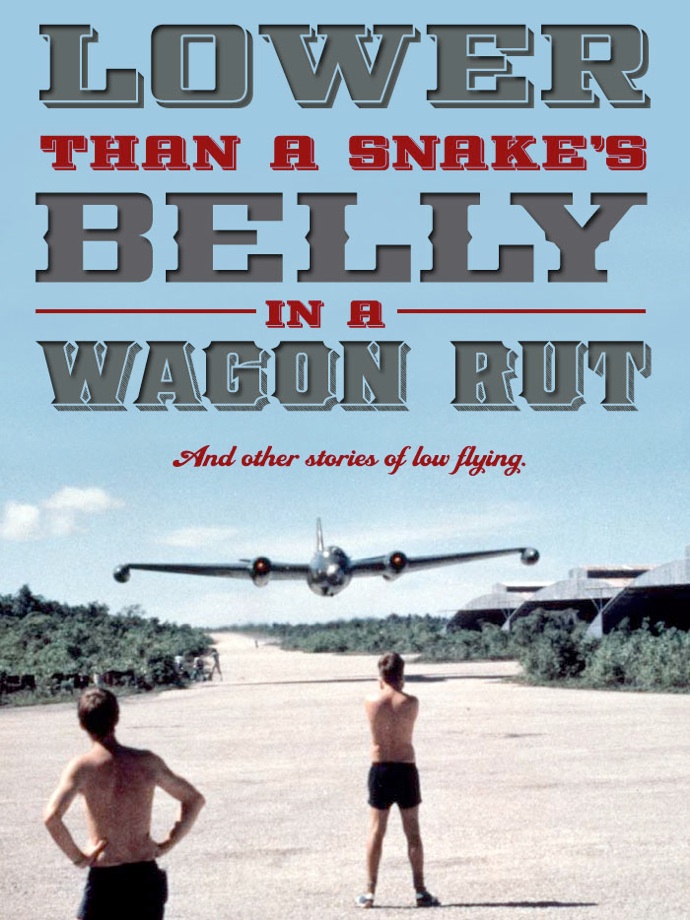
On a particularly hot day, a Royal Australian Air Force English Electric A84 Canberra bomber drops to within 25 feet as thrill-seeking mechanics get ready for the visceral experience of 13,000 lbs of Rolls Royce Avon power full in the face. RAAF Photo
They loved to fly low in World War Two
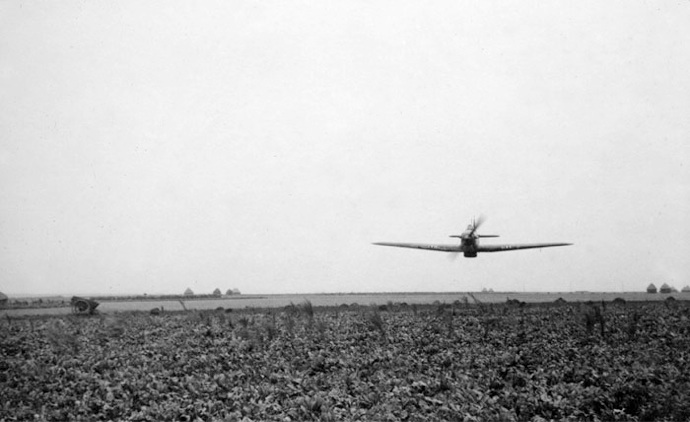
'One more beat-up, me lads.' Flying Officer Cobber Kain, DFC, a New Zealander and the RAF's first ace of the Second World War, is seen here in France performing a low-level flypast. Kain, it has been said, clipped the ground with the propeller throwing grass into the radiator.
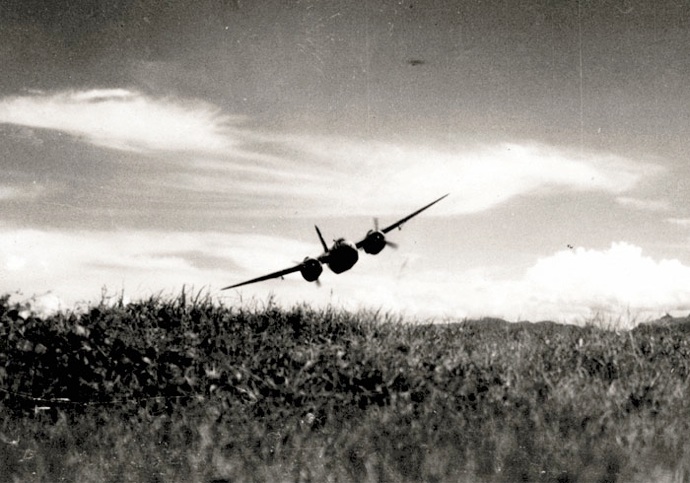
A Douglas A-20G Havoc night fighter of the 417th Night Fighter Squadron does a little daylight low flying down in the weeds possibly near the Orlando , Florida base where they were formed. Their first deployment was to Europe where they immediately re-equipped with Bristol Beaufighters. Today, the unit still trains for a night time job, but flying the F-117 Nighthawk or so-called “Stealth Fighter”.
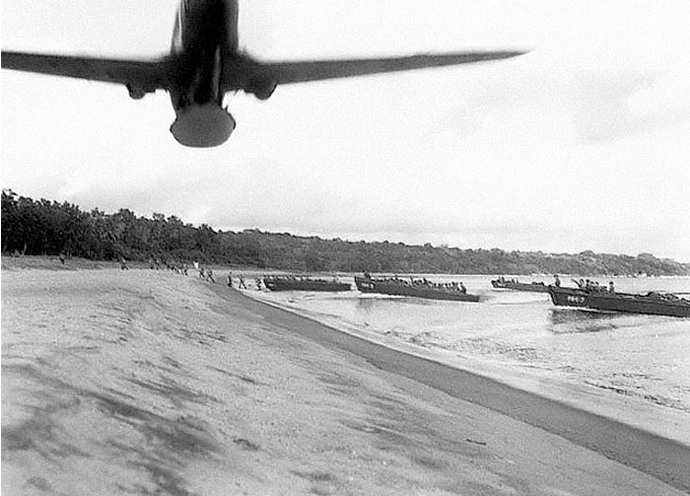
A P-40 flies down the beach at extreme low level, as Marines practice an amphibious landing somewhere in the Pacific. In order to get this photo, the photographer standing on the beach would have had to have his back to the oncoming P-40 trusting that pilot would do a “buzz job” of the beach and not his hair. Photo via Project 914 Archives, Steve Donacik
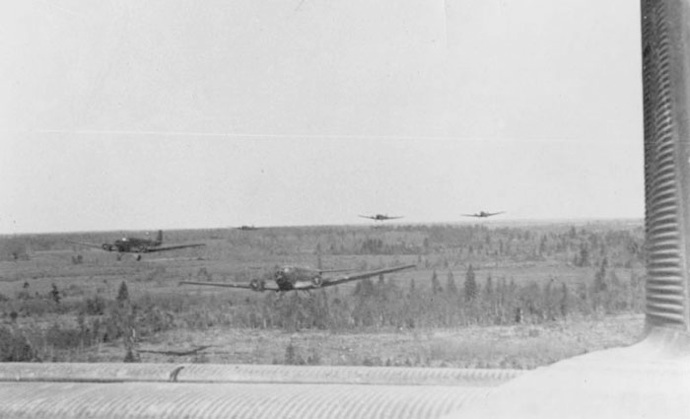
A squadron of Luftwaffe Ju-52 Junkers stream low over the Russian countryside near Demjansk, south of Leningrad . In February to May of 1942, the Germans were surrounded by the Red Army. Supplying the Germans during and after the "Demjansk Pocket”, was the role of the air force. Here, low flying in the slow transports was more a survival tactic than a joyride. Photo via Akira Takaguchi
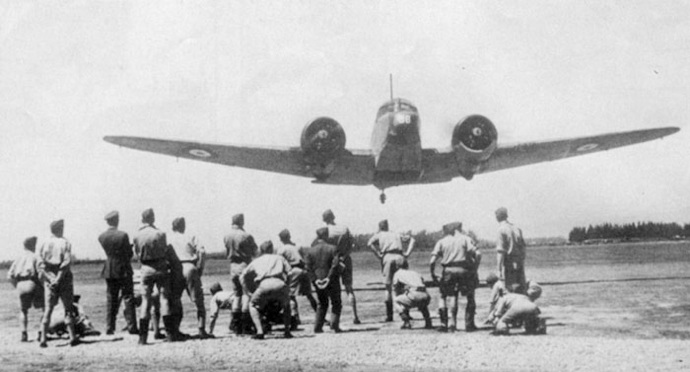
Thought to have been taken in the region of Canterbury, New Zealand in 1944, this shot of an Airspeed Oxford scaring the beejeesus out of half the waiting airmen while the other half remain calm, is a beauty. Photo via Joe Hopwood.
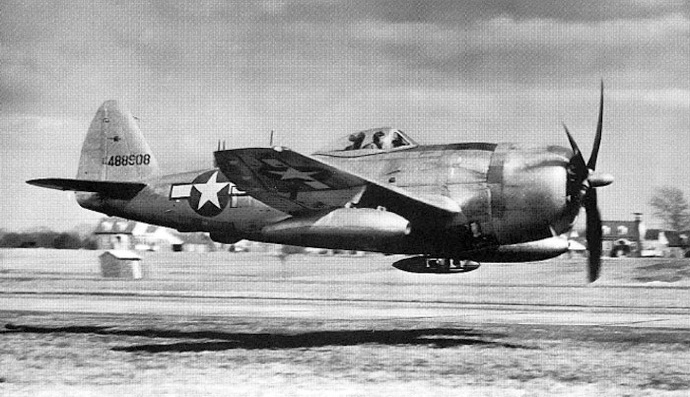
A USAAF P-47 Thunderbolt at extreme low level. Note that the sweep of the camera's pan has bent the buildings in the background
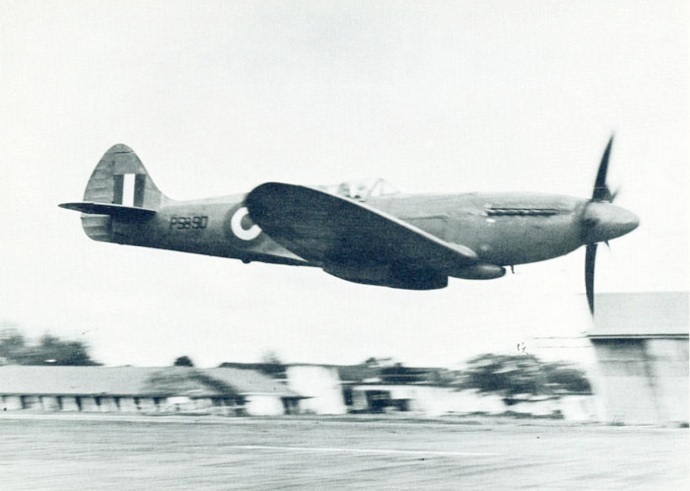
Another shot that has the same effect of bending the buildings in the background (see previous photo). Like our own Spitfire XIV RM873, Griffon-powered PR Spitfire XIX PS890 was sold to the Royal Thai Air Force after the war. She is seen here with 81 Squadron markings and being put through her paces down low at RAF Seletar , Singapore in the summer of 1954 just before her sale. In 1961, PS890 was donated to the Planes Of Fame Museum in California . It was eventually restored and took to the skies again in 2000, albeit with clipped wings and contra-rotating props. It was then purchased by Frenchman Christophe Jacquard and taken to Duxford for the wingtips to be added and a single 5-bladed propeller installed.
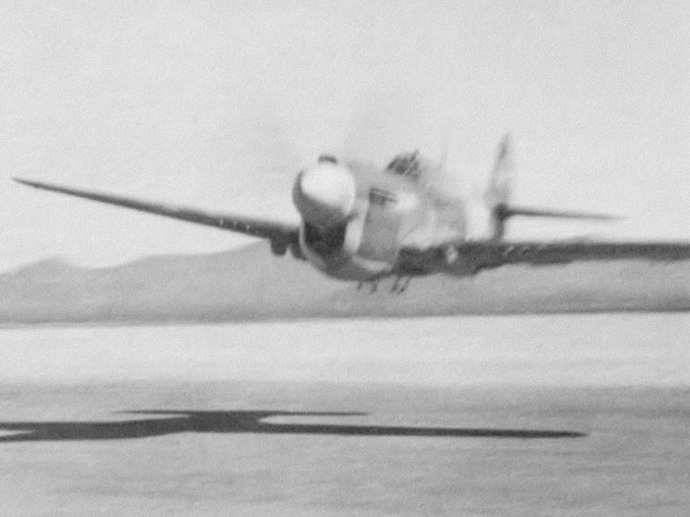
While researching images for our P-40 stories over the past year I came across a massive collection of marvellous wartime photos - mostly of P-40s collected by Steve Reno. This P-40 pilot is risking his life only a little less than the man taking the photo of this ridiculously low level pass across the runway. He’s not much higher than he would be if he was standing on his landing gear! If you trace the invisible line of his prop arc, this skilled numbskull’s tips are only about 4 feet off the ground. Photo via Project 914 Archives, Steve Donacik
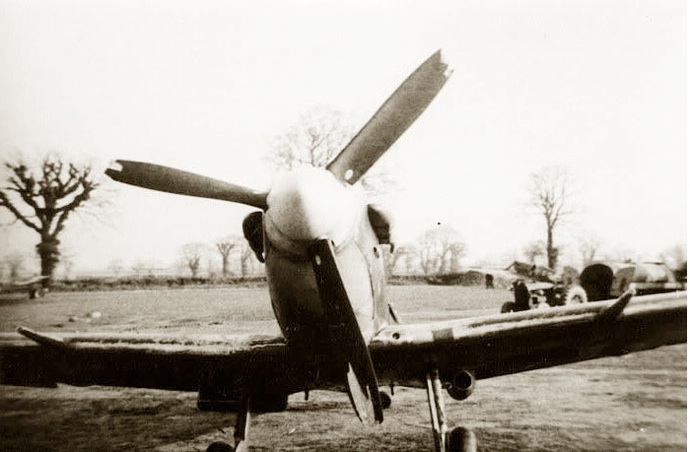
Some aircraft, such as this Spitfire, reach that fine line between crashing and flying low... about 12 inches too low in the case of this 64 Squadron Spitfire with shattered wooden blades. The aircraft, no doubt shaking badly was nursed back to the safety of an Allied base.
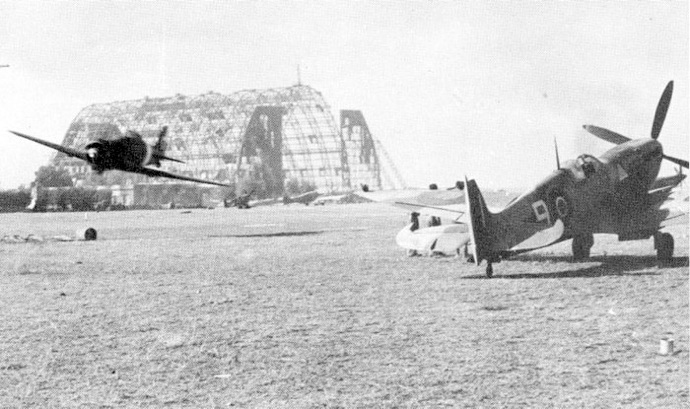
An Allied pilot flying a Macchi 200 buzzing Taranto , Italy . It sadly proved that these kind of stunts aren't without danger as the pilot hit a member of the ground crew and more or less decapitated him. The pilot hadn't noticed a thing and after landing was confronted with a dent in his wing's leading edge, containing skull fragments.
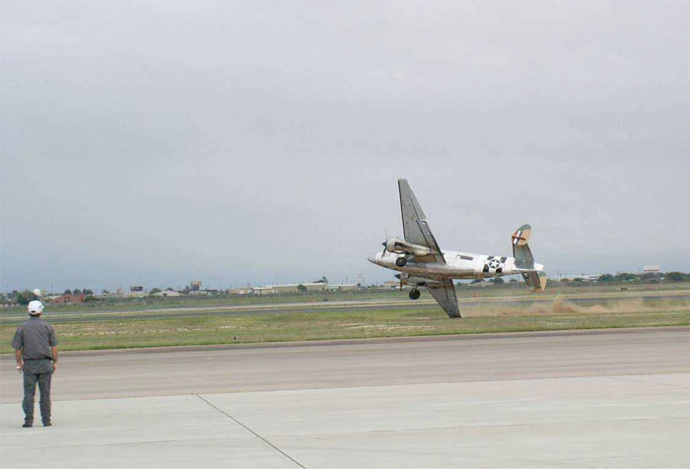
I didn't want to include any shots of an aircraft landing or taking off, just low level flight, But this shot of a Lockheed Harpoon/Ventura dragging its wing in the turnout is interesting enough to include
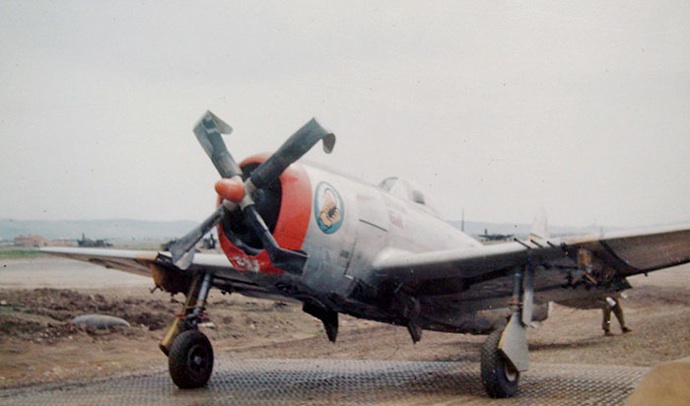
A P-47 of the 64th Fighter Squadron, while on a mission to Milan , struck the ground during a low level strafing run. Despite the bent props and crushed chin, the pilot nursed the Jug 150 miles home to Grosseto . Photo via Hebb Russell
Film makers love low level flying!
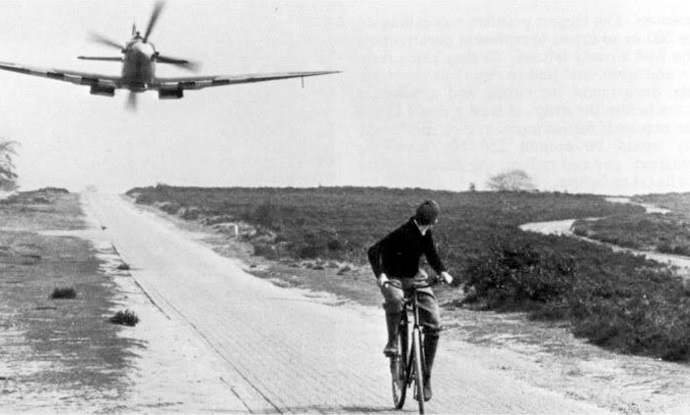
Not actually a scene from the Second World War, but rather the opening scene in the great film A Bridge Too Far. A school boy watches over his shoulder as a recce Spitfire rips up a cobbled road in Normandy .
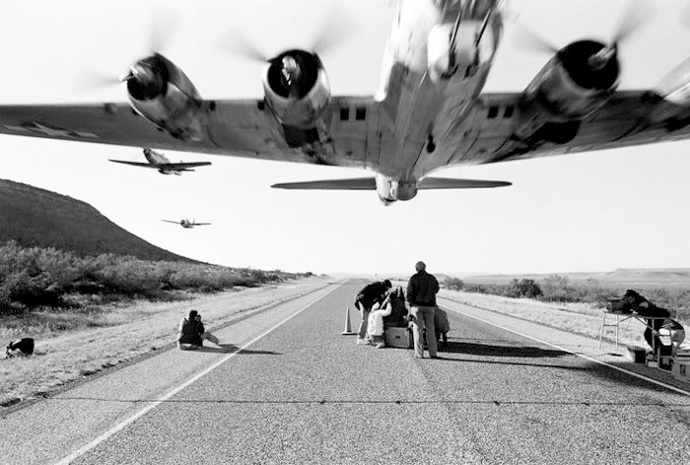
Modern day photographer Murray Mitchell captured this action shot super low B-17 Flying Fortress performing for a film crew and followed by a P-51D Mustang and a P-47 Thunderbolt. Photo viawww.murraymitchell.com
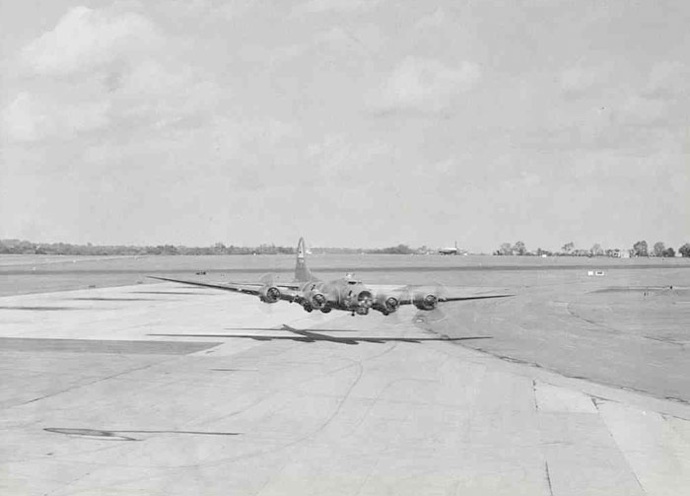
A low fly-past during the filming of the Steve McQueen-Richard Wagner film, The War Lover. Nothing like a good buzz job to get the juices flowing, in this case one of theWar Lover ex PB-1Ws being flown by John Crewdson for a key scene in the movie. Crewdson reportedly flew the airplane solo for the sequence. Photo by David M. Kay
Unoccupied desert and sun-baked boredom causes low-levelitis
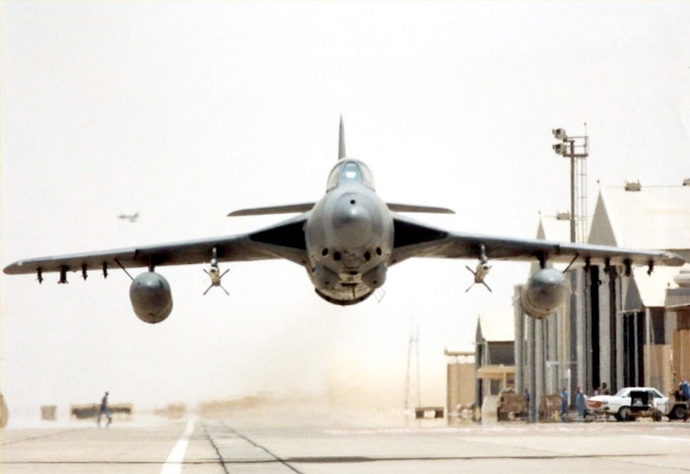
A particularly heart stopping photo of a Hawker Hunter of the Sultan of Oman 's Air Force beating up the base at Salalah. The Sultan employed mercenary Brit pilots to fly Hunters and Strikemasters to help put down the Dhofar rebels in the south. They clearly were bored from time to time! The rebellion ended in 1976, the same year I visited Oman .
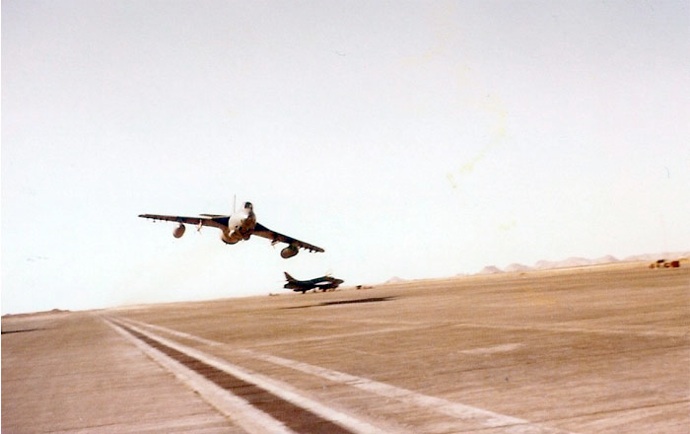
A Hawker Hunter pilot of the Sultan of Oman 's Air Force (SOAF - possibly a former RAF mercenary) shrieks across the ramp on an Omani air base. Photo viaPatricksAviation.com
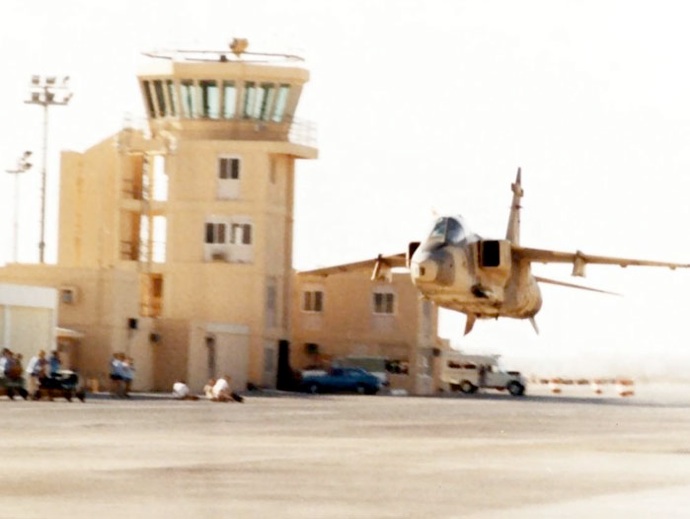
In the shimmering white heat of an Omani summer day, a Sepecat Jaguar adds superheated jet exhaust to the miserable mix as its pilot shows off for the ground personnel watching from the shade. In 1990, the SOAF was renamed the Royal Air Force of Oman (RAFO). It is not known if this is a SOAF or a RAFO Jag,
But forest, buildings and mountains make it more exciting
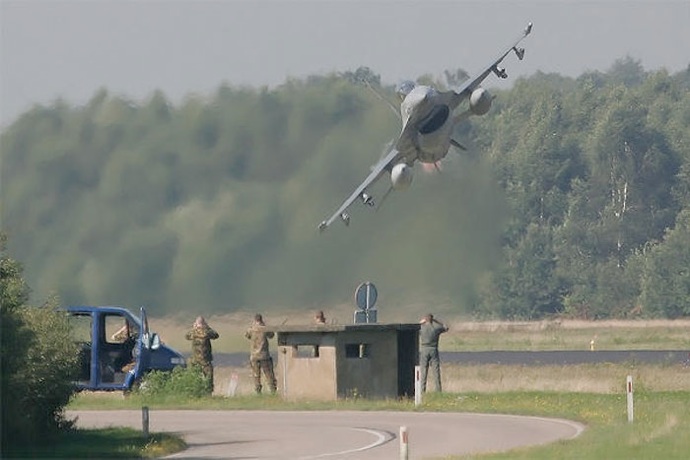
A Dutch F-16 with burner lit seems to follow the turn in the road. On the ground, Dutch airmen stuff fingers in their ears as he passes over head.
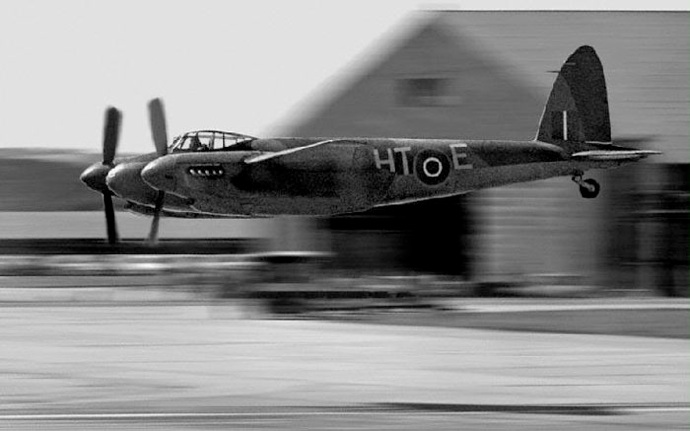
Testosterone fired, speed addicted, and happy-to-still-be-alive youth were the primary source of pilots of the Second World War. At 6 foot, 4 inches, I wouldn’t want to be standing up on the runway for this beat-up by a Mosquito. This aircraft had the military serial number RR299 and was built as an unarmed, dual control trainer at Leavesden in 1945. It served in the Middle East until 1949, when it returned to the United Kingdom . It then served with a variety of RAF units, this service being interspersed with periods in storage. The aircraft was retired from the RAF in 1963 and was acquired by Hawker Siddeley Aviation (now British Aerospace) at Chester . The first Permit to Fly was issued on 9 September 1963. The aircraft continued to be based and maintained at Chester and typically flew around 50 hours per year. Photo RAF
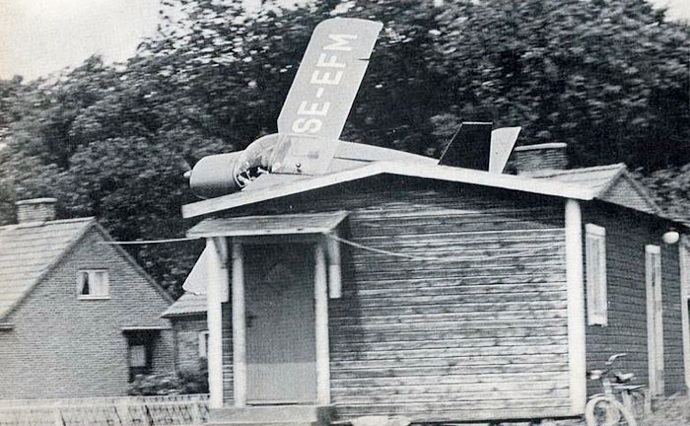
Saab test pilot Ove Dahlen flies a mini-counter-insurgency aircraft variant of a trainer, known as the Malmo MFI-9B, between houses in Sweden . The concept of a super-light, super-cheap attack aircraft with hard points for rockets was not well received and SE-EFM was eventually sold (as all other MFI-9B trainers were) as a civilian sport/general aviation aircraft, but for a while it was a bad-ass attack aircraft clearly capable of sneaking around buildings. Though SE-EFM and the purpose-built mini-COIN concept did not take hold, 5 airframes of the MFI-9B trainer, known as the Biafra Baby, were fitted with rockets and employed in the conflict in Biafra.
Bombers do it.
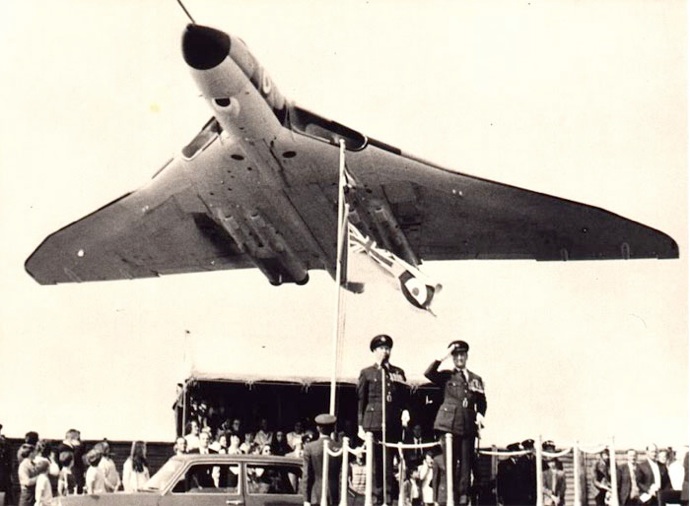
This is my favourite of all the low level shots, as the people (except the man on the left who is smartly covering his ears) have no idea how low this Avro Vulcan really is as it sneaks up behind them. The flag is at half staff, so this most likely was a sad occasion, but there were no doubt some shrieks and some Olympic flinching when the sound reached them.
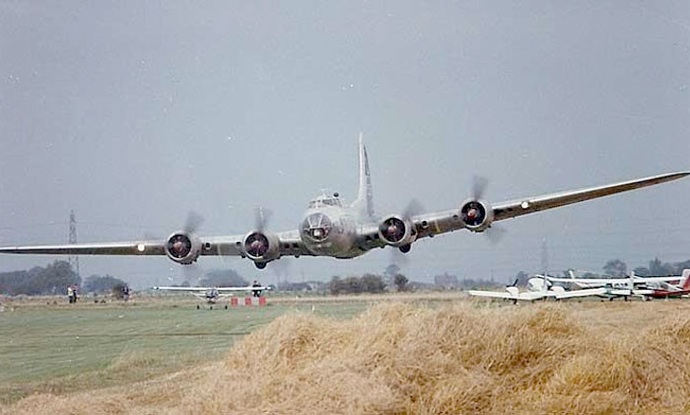
A British-based B-17 beats up a grass field
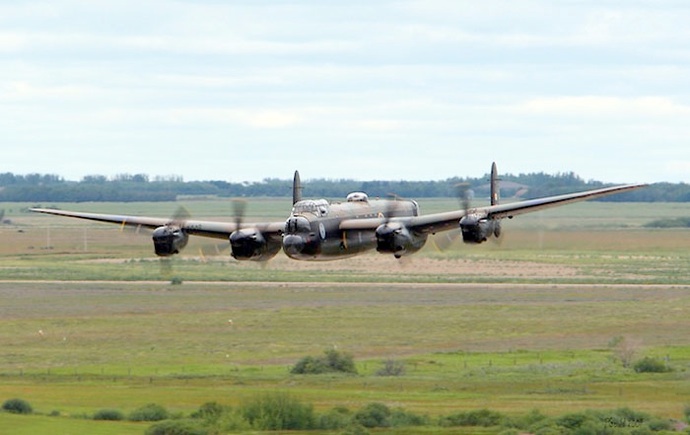
The Canadian Warplane Heritage Lancaster drops down to the infield of the Saskatoon airport.
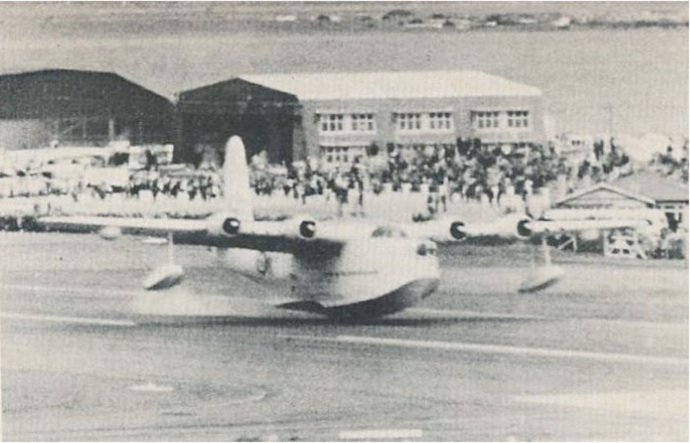
Royal New Zealand Air Force Short Sunderland doing a touch and go at Wellington airport in 1959 - Surely no-one can go lower than that! A touch and go in a wheel-less flying boat is not recommended. You couldn't get a damn slice of pastrami between the hull and the runway. There exists a crystal-clear shot in one of the RNZAF flight-safety publications that showed the aircraft just after it had done the "touch and go" clearly showing the bilge water escaping. Spectators were treated to a shower of dirty bilge water as it climbed away.
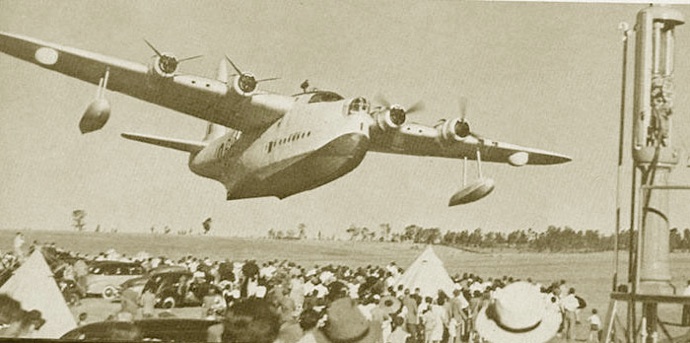
Another Sunderland being 'demonstrated' at Port Elizabeth , South Africa , may not be as low, but the pilot gets full degree of difficulty points for having two props feathered!
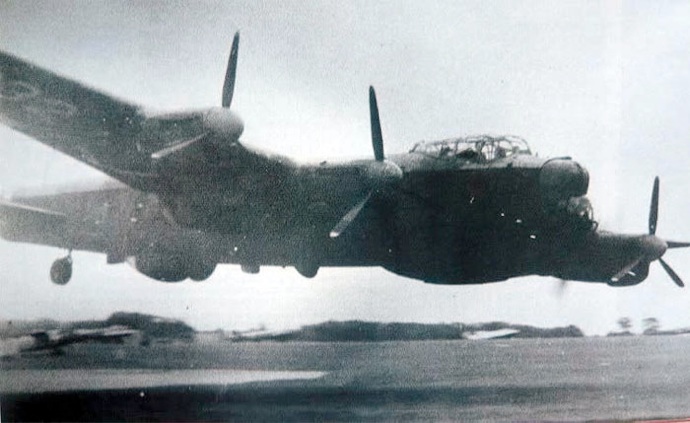
Thought two feathered engines on the same side was impressive for low level flight? How about three feathered and 20 feet below? This Avro Lancaster appears to be post war with the nose turret de-activated and a dome in the dorsal position. This is a very foolish maneouvre.The aircraft can't be flown on a single engine. It's done by a dive, a high speed pass and a zoom climb at the far end of the runway with a mad scramble to unfeather. The situation gets serious if the first unfeathering knocks the generator on the good engine off line, leaving only battery power. Photo via Blake Reid
Rhinos LOVE to do it.
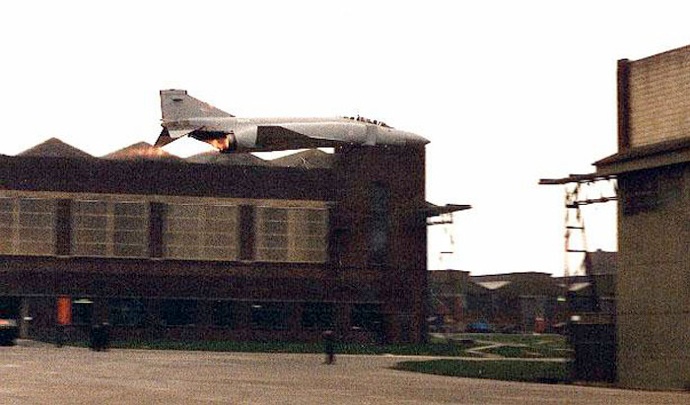
An RAF Phantom II in full burner passes between two hangars at an RAF base. There isn't a Rhino-driver alive who didn't love dropping his locomotive-sized Phantom down to the hard deck and pushing the throttles right past the detents.
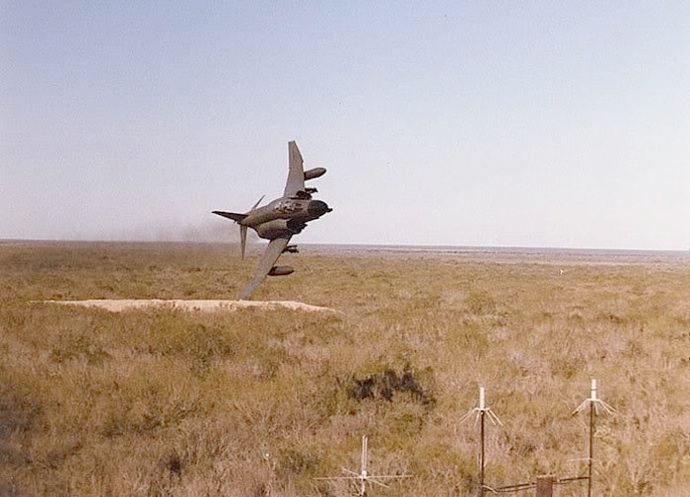
Like I said before, Phantom drivers love it down low
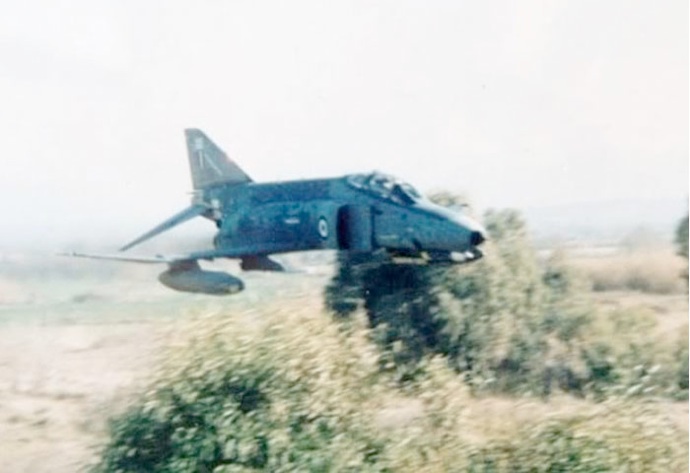
Flying even lower than the Greek economy is this GAF F-4 Phantom II picking its way through the bushes.
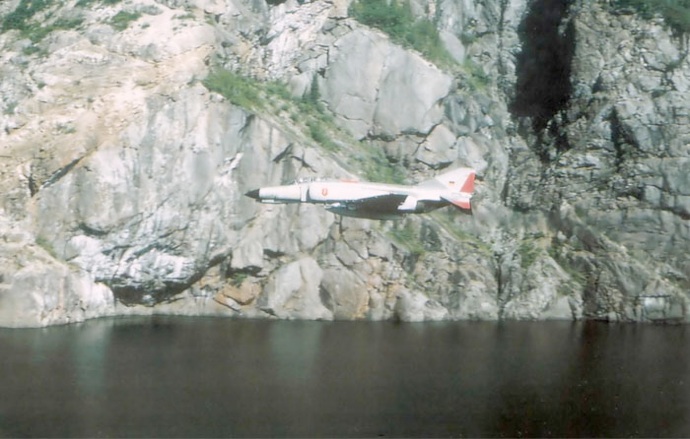
Down low, add in a little rock and some flat water and the fun escalates. Not sure what air force this one belongs to
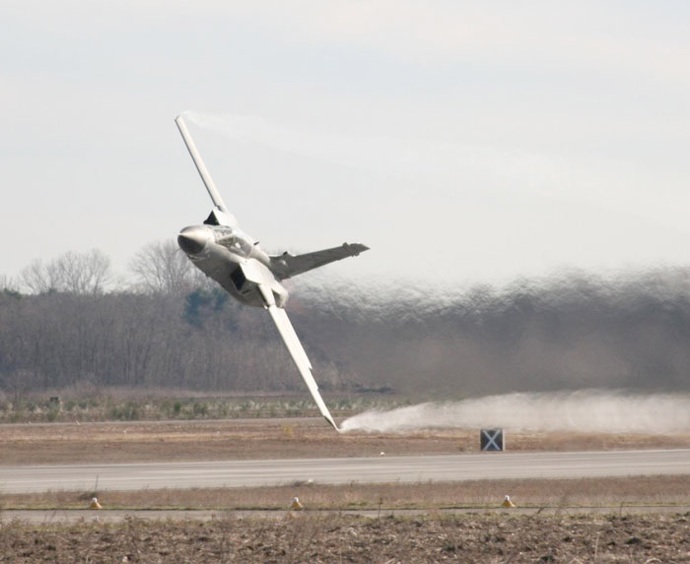
A Panavia Tornado spews heat, gas, and vapour as she howls from the runway with her wingtip a few feet off the ground.
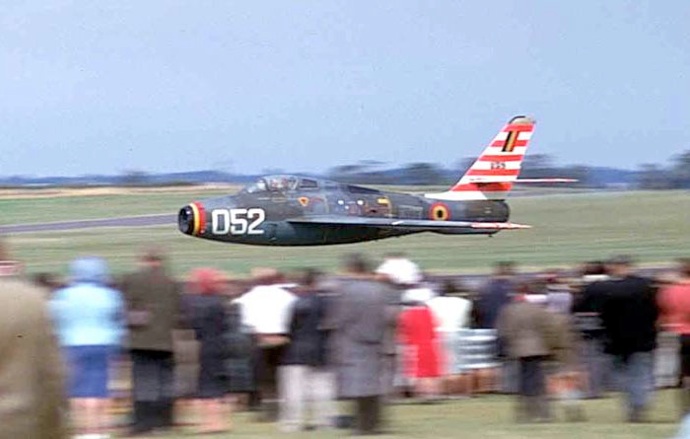
During an air show at RAF Wethersfield in 1964, a Belgian Air force pilot in a North American F-84 Thunderjet flies not only feet off the ground, but apparently just feet from the crowd. Times have changed. While perhaps not as exciting for the spectators, but certainly safer.
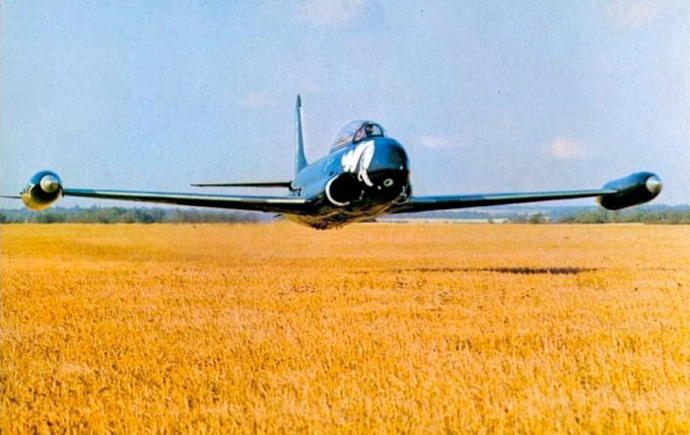
The legendary Ormand Haydon Balllie checks our wheat production at a farm outside of Duxford in 1974 in his T-33 (RCAF 21261) The Black Knight. Born in Devon , England during the Second World War, OHB moved to Canada in 1962, joining the RCAF. He would become a well known warbird collector and pilot after his service.
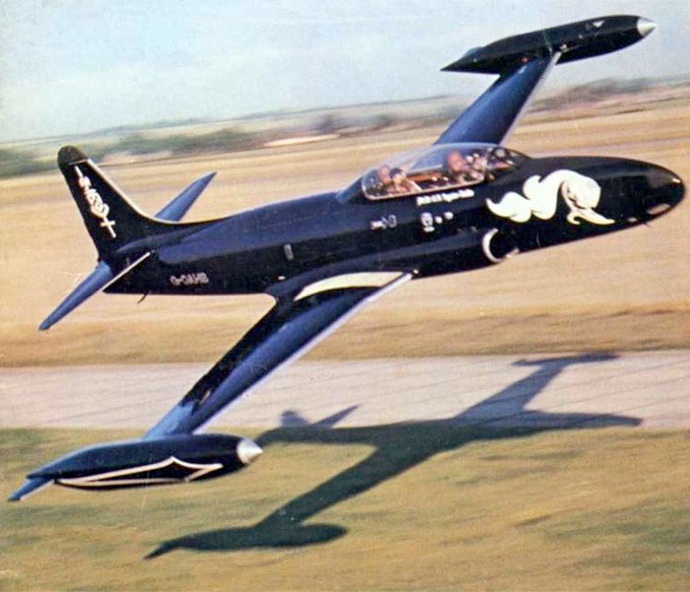
Another crazy low pass by Ormand Haydon Baillie in his Black Knight T-33 Silver Star.The spectacular paint scheme is based on an RCAF design for 414 Black Knight Squadron that flew the type. Vintage Wings of Canada is proud to have been part of 414's history. The squadron was disbanded in the 1990s. However, in December of 2007, approval was received for the squadron to stand up once more, this time as 414 EWS (Electronic Warfare Support) Squadron. Belonging to 3 Wing Bagotville, the squadron is based in Ottawa and is composed of military Electronic Warfare Officers who fulfill the combat support role, flying on civilian contracted aircraft. The squadron was re-formed at the Vintage Wings hangar at the Gatineau Airport on 20 January 2009 to operate the Dassault/Dornier Alpha Jet provided by Top Aces Consulting.
Haydon-Baillie died in Germany in a P-51 Mustang on July 3, 1977.
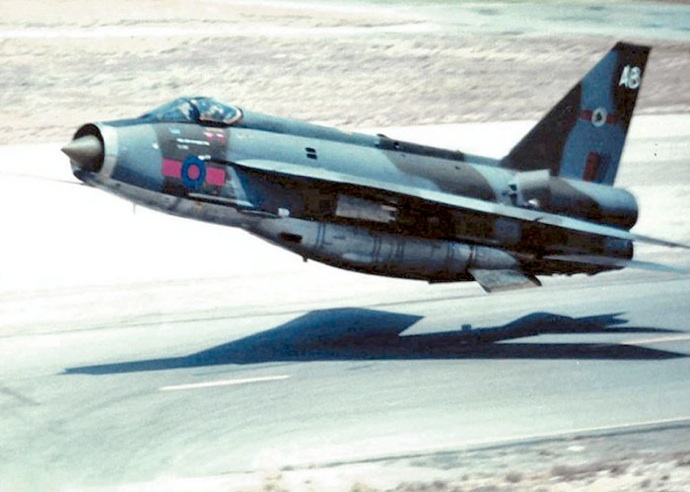
With speed brakes out, I am not sure whether this is a shot of a pass or a wheels-up landing for this British Electric Lightning
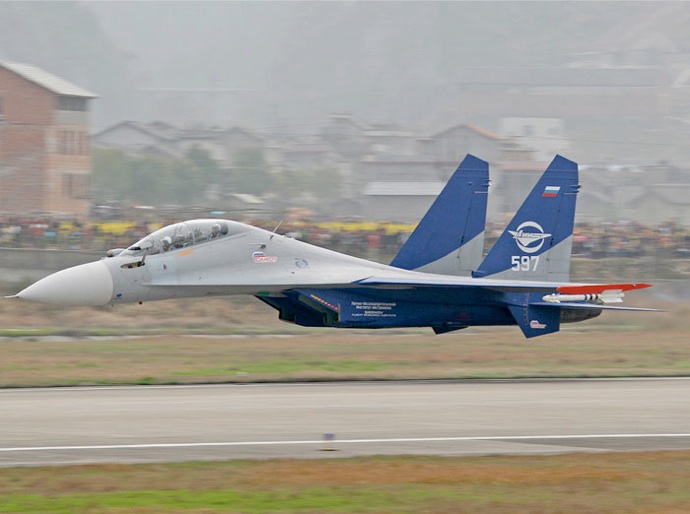
This Sukhoi Su-30 could be going Mach .98 or it could be hovering.
Even airliners do it
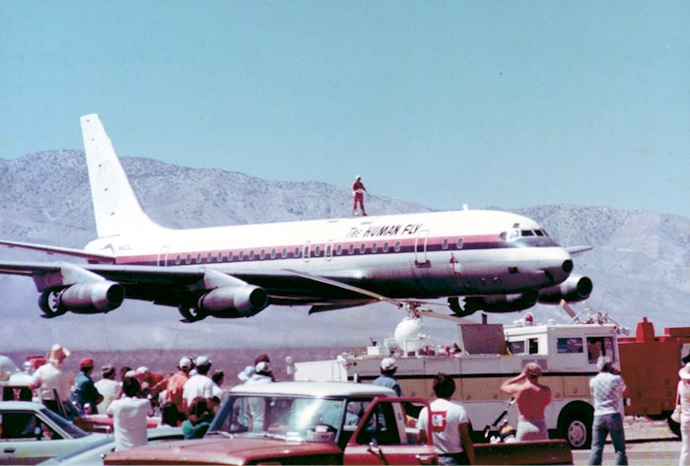
The Human Fly, a stunt man by the name of Rick Rojatt, makes a low pass on top of a DC-8 flown by the legendary Clay Lacy in front of the grandstands between events at the 1976 California National Air Races at Mojave. The aircraft is ex-Japan Airlines JA8002. It was owned and operated by American Jet Industries in 1976.
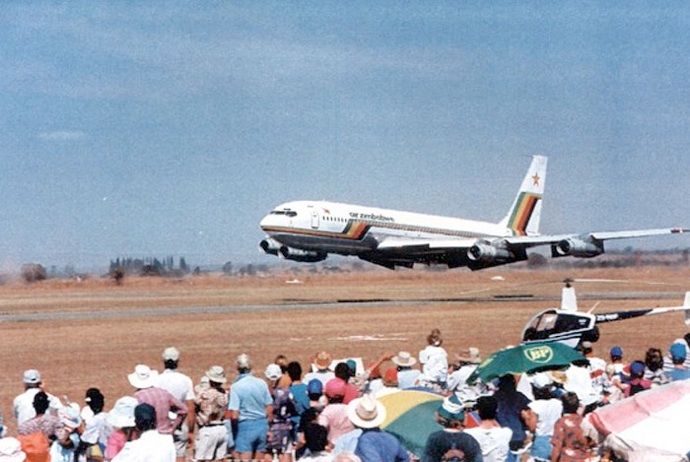
A Boeing 707 of Air Zimbabwe, flown by Darryl Tarr doing a low level, high speed flypast in Harare in 1995. According to witnesses, this was not the lowest the pilot flew. Tarr says that his radar altimeter read 6 feet beneath his keel at one time. Many believe that the flight was unauthorized and that Tarr was fired because of it, but he states that he made two flights) and they were both authorized. He recounts the facts of the flight in fine detail: 1. Three Crew members only on-board (Flight Engineer, First Officer, and myself) 2. Non- Revenue Flight (or non-commercial flight as some prefer) 3. 12,000 KGs of Fuel (2.0 hours endurance) 4. VREF Approach Speed Flaps 40 was 116 Knots (I was flying at 125 Knots) 5. Radio Altimeter call of 30 feet (from the FE), will be my cue to initiate a Go-Around 6. Back-up call from the F/O, plus visual cues (outside references due to the pitch attitude) 7. Rising ground and the fact that the aircraft is rotated towards +15 degrees in a Go-Around, the empennage will initially rotate downwards and get lower to the ground which was accounted for (as depicted in the photo, the aircraft is climbing) 8. High Speed Fly Past (which is not shown here), was at the Barbers Pole of 375 KIAS (due to the density altitude at Harare True Air Speed was 400 Kts)
A beach makes a good open area to fly low in.
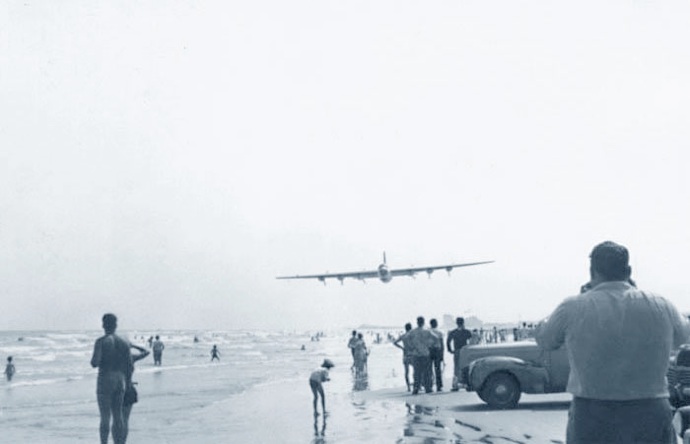
I can't even imagine how amazing it would have been to be on the beach this day to see a Consolidated B-36 “Peacemaker” fly down the line between water and sand. If he passed right overhead, both wingtips would be a spectacular 115 feet away in both directions. Designed for altitudes in excess of 35,000 feet, the Convair was a rare sight this close to the ground in level flight.
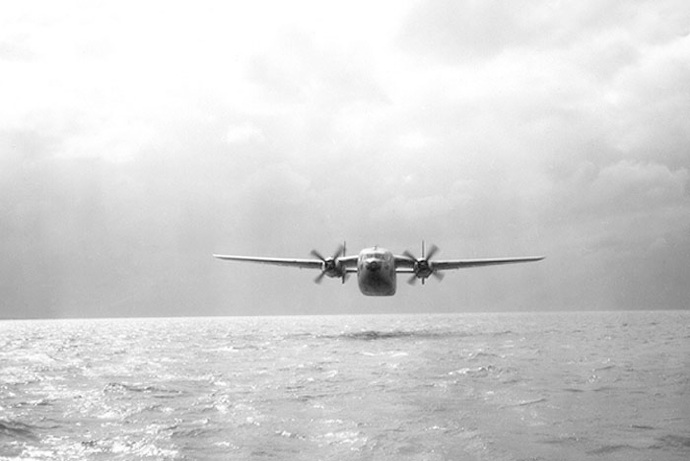
A spectacular shot of a Fairchild Provider flying low over sunlit waters... one of my favourite shots! via Blake Reid
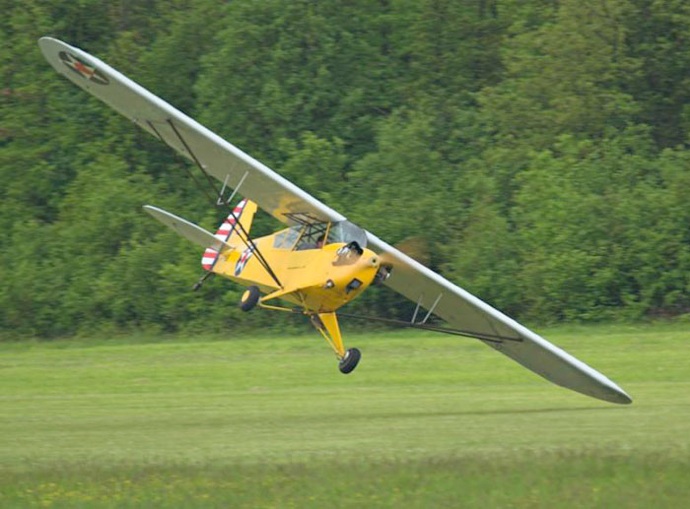
Sometimes, the difference between ground and aircraft is quite literally... inches. A Piper Cub comes as close as possible to a wing strike without damage.
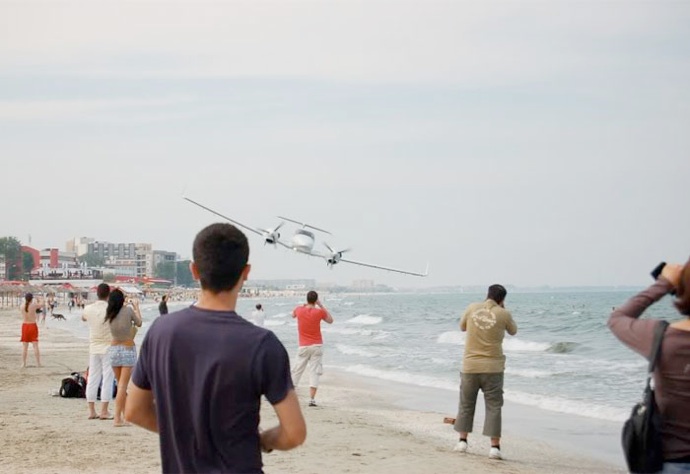
The twin-engined Diamond Star Twin rips along a beach. Judging by the number pf cameras at the ready, this was not an unauthorized fly by.
The Navy loves to do it
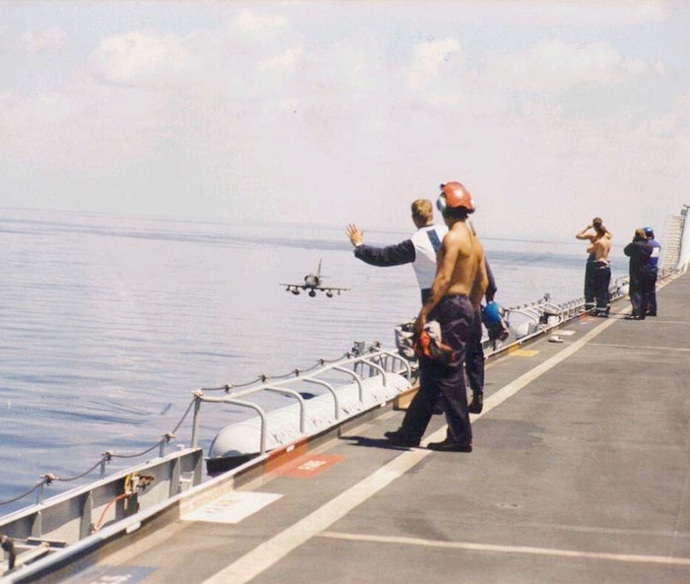
An Australian A-4 Skyhawk flies well below the deck of HMAS Melbourne .
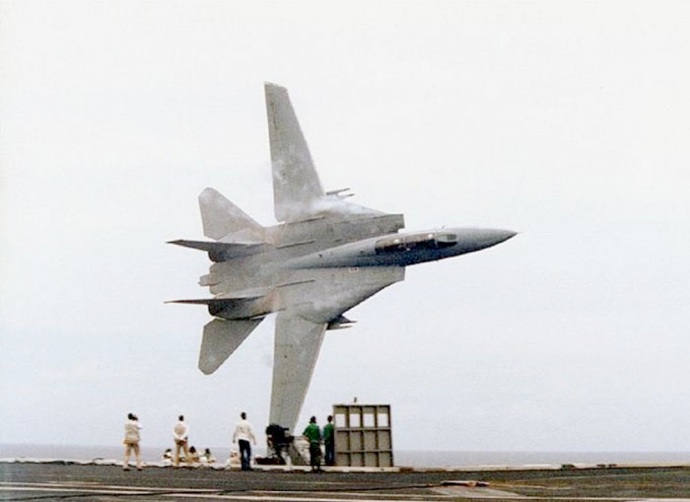
One of the most celebrated images of a low pass is this shot of F-14 Tomcat driver Captain Dale “Snort” Snodgrass making a curving pass alongside USS America. Many web-wags have stated that this was unauthorized, dangerous or that it even was a photo of a Tomcat about to crash. However, Snodgrass explained: "It's not risky at all with practice. It was my opening pass in a Tomcat tactical demonstration at sea. I started from the starboard rear quarter of the carrier, slightly below flight deck level. Airspeed was about 270 kts with the wings swept forward. I selected afterburner at about a half-mile out, and the aircraft accelerated to about 315 kts. As I approached the fantail, I rolled into an 85-degree bank and did a hard 5-6G turn, finishing about 10-20 degrees off of the boat's axis. Microseconds after this photo was taken, after rolling wings-level at an altitude slightly above the flight deck, I pulled vertical with a quarter-roll to the left, ending with an Immelman roll-out 90 degrees and continued with the remainder of the demo. It was a dramatic and, in my opinion, a very cool way to start a carrier demo as first performed by a great fighter pilot, Ed "Hunack" Andrews, who commanded VF-84 in 1980-1988.
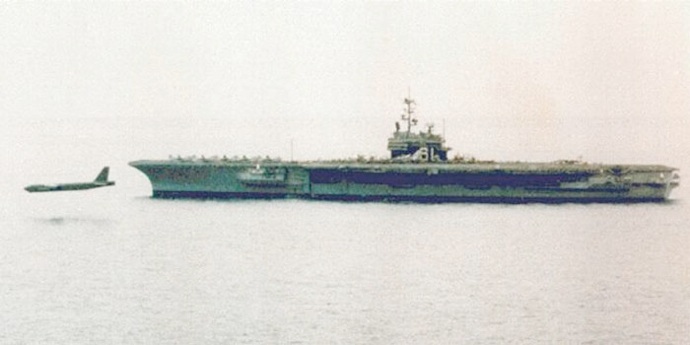
A B-52 slides down the port side of USS Ranger (CV-61) in its typical nose down cruise attitude. Though it looks like it, this is not photoshopped. It happened in early 1990 in the Persian Gulf, while U.S. carriers and B-52s were holding joint exercises. Two B-52s called the carrier Ranger and asked if they could do a fly-by, and the carrier air controller said yes. When the B-52s reported they were 9 kilometers out, the carrier controller said he didn't see them. The B-52s told the carrier folks to look down. The paint job on the B-52 made it hard to see from above, but as it got closer, the sailors could make it out, and the water the B-52's engines were causing to spray out. It's very, very rare for a USAF aircraft to do a fly-by below the flight deck of a carrier. But B-52s had been practicing low level flights for years, to penetrate under Soviet radar. In this case, the B-52 pilots asked the carrier controller if they would like the bombers to come around again. The carrier guys said yes, and a lot more sailors had their cameras out this time. Photo was taken from the plane guard helicopter
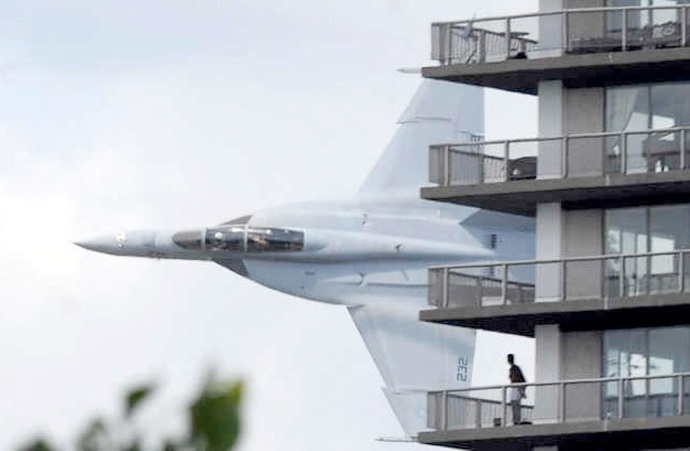
In 2009, a Navy F/A-18F Super Hornet crew got permission for a low-level demonstration flight as part of the opening ceremony for a speedboat race on the Detroit River , This is what it looked like for Motor City residents. Officials waived rules to allow the Navy flyers to swoop under 100ft along the waterway. One resident said, "I couldn't believe how low they flew and how close they came to our building. I'm sure the pilot waved at me." Photo: AP/The Detroit News, Steve Perez. Originally spotted at the Daily Mail.
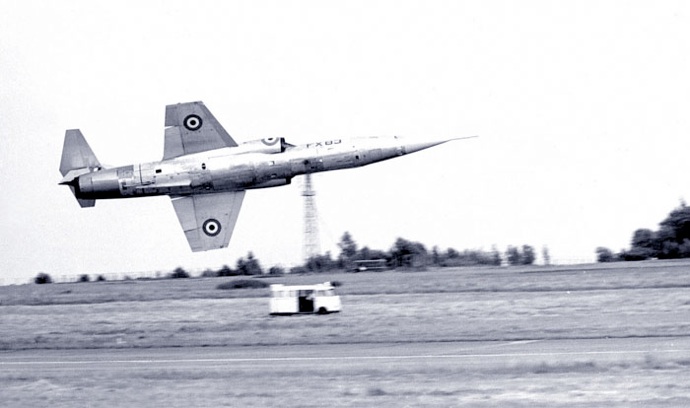
A Greek F-104 turns out after a high speed low level pass.
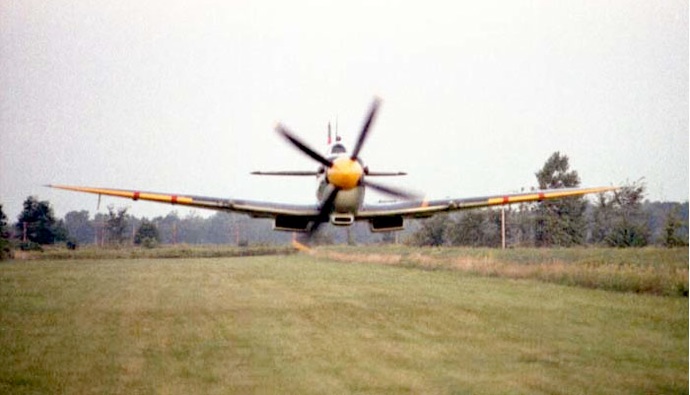
The Spitfre MK923, belonging to Hollywood actor Cliff Robertson of Baa Baa Black Sheep fame, and flown by Jerry Billing, does a extreme low pass over a grass strip at his home in Essex County, Ontario. From 1975 through 1994 the Billing air strip was a prime spot to see Jerry practice in MK923. People would line the 5th Concession Road to watch Jerry wring out the Spit. Cliff Robertson, famed for playing JFK in PT 109, died in September of 2011. Photo via Bob Swaddling
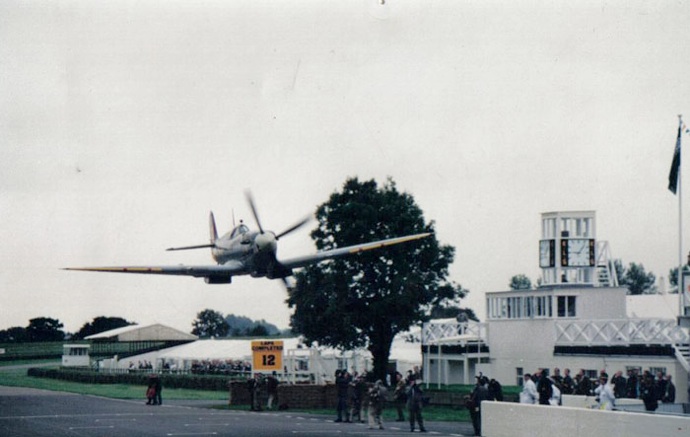
The legendary, extraordinary Ray Hanna a New Zealander makes an extreme low level pass in a Spitfire down pit lane at the Goodwood auto racing track in England in 1998. Sadly, with the death of Hanna, we will not see such feats again.